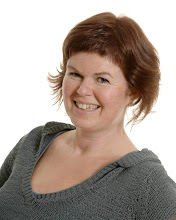The next step of this wanna tri? play-along is both the most frustrating and fun part of the process.
We will put the triangles on the design wall and start the puzzle.
My design wall is a large piece of Warm and Natural cotton batting partly hung by curtain clips and partly taped to the wall with painters tape. A design wall is a must have for working like this. If you haven't tried it yet I have to tell you it is a wonderful tool...
I choose to make my third equilateral triangle quilt top from the summer garden bundle and started by cutting triangles from half of the fabric, randomly placing them onto the design wall. This way I could see how much of a contrast in value they had, and how well the colors played together. By cutting only half of the fabric first you can better judge if the rest of your preselected bundle will mix well, and then decide which one to add and which one to leave out.
At first it's all quite chaotic, and easy to think there's no way this will work! This is part of the process, don't panic yet...
My summer garden bundle contained a few Martha Negley flowers in different palettes that all seemed to play well together. I decided to let them be the focus fabric, and try to build a palette around them. They would stay, others would have to leave the party if they didn't mix well.
Stepping back and looking at the design wall, I noticed that the dark green Wood Ear print didn't play so well with the rest. They were the first to leave. Stepping back again, I saw the same thing happened with the orange and pink non-floral prints. So they were taken away, too.
Now the colors mixed well. Still, the overall impression was quite busy...
I noticed that my three colors of Aboriginal dots would be a good backdrop for the busy flower prints. Luckily I has a large piece of the pink Aboriginal dots, and decided to put them in a checkerboard grid as a base...
This grid was a good reference for size. And as help to place the rest of the triangles...
I then started filling out the grid, little by little in a random fashion...
focusing on the distribution of print and value...
filling in all the patches first
then breaking up the regularity of the grid...
The essence of working this way is using your eyes to judge what you see in front of you:
- step back, assess, replace a triangle, then another, step back ...
- swap a few triangles, step back ...
- and then move a few triangles around, working towards "random" ...
Once you are happy with your layout, I think it's good to leave it for 24 hours before sewing them together. This will give you a chance to see the contrast at different times of the day (morning, mid day and evening) and also notice a few little changes you would like to make. Walking away is important, to get a fresher look when you return. A reduction glass can also be a helpful tool. I have a I cheap door viewer that helps to focus on the overall value distribution in the top.
So, what's next?
Next step is sewing the triangles together. I am going to leave my layout for at least 24 hours before I will start sewing them together. The next post will make a few suggestions and share a few ideas on how to turn the puzzle into a flimsy...















5 comments:
I'm really enjoying watching your process. Thanks for sharing!
I really do want to try this quilt but it can't be right now. I'm loving your process, it's like I'm there watching how you work and I love that you are making it more random.
This is going to be so beautiful! I love the colours and prints! For the moment I don't even have a wall for a design wall but I was wondering do those pieces stay on there on their own? x Teje
It was well worth all the swapping around, your colours are well balanced I think..I'm just thinking..can I make one?
I am really enjoying this series even though I'm not actually making the quilt! Thank you.
Post a Comment